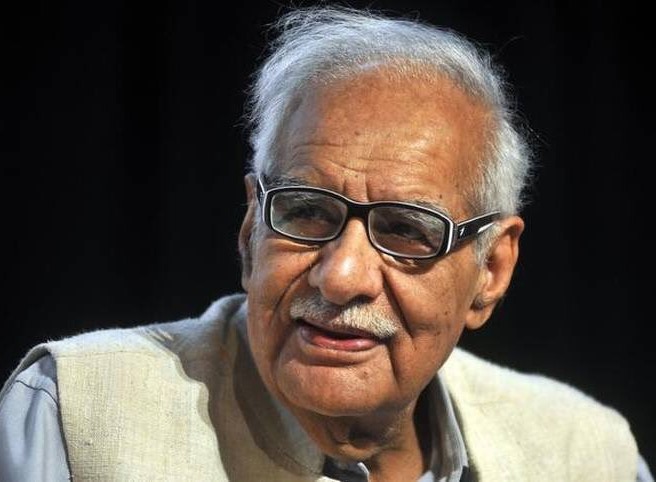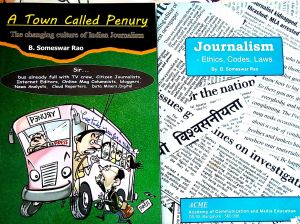
VETERAN JOURNALIST KULDEEP NAYAR passed away today, at the age of 95, perhaps bringing to close with him an era of honest reporting in this age of fake and paid news.
Thousands of journalists, political leaders and people in public life condoled his death — some of them not even knowing the names of his 15 books or his name itself. Former Shiv Sena leader and now Maharashtra Congress president Sanjay Nirupam tweeted “Veteran journalist Shri Kuldeep Nayer’s demise is a big loss to Indian journalism. He was a peace activist & a great nationalist. Have fond memories of working with him in Rajya Sabha. Beyond The Line & India after Nehru were his most popular books. My condolences to his wife Bharti.”
Nirupam does not know that Kuldeep spelt his name as Nayar, unlike most Punjabi Nayyars and one Punjabi who adopted the Malayalam version, Hollywood film-maker Meera Nair.
And his most famous book on (the then) current affairs was ‘Between The Lines’ not ‘Beyond The Line’ as mentioned by Nirupam, who perhaps did not read Kuldeep’s bylined column of the same name. The condoelnce served only to remind readers that he, Sanjay, was a member of Rajya Sabha.
A Pakistani daily, The Express Tribune, distorted RIP (Requisit in Pace or Rest In Peace as commonly understood) to ‘Rest in Power’. Had he hankered after power, he would have cashed his job as IO in Press Information Bureau, later, or as Press Secretary to Prime Minister Lal Bahadur Shastri.
Anyone who is 80 and waiting near the exit gate of life, for it to open, is likely to read most obituaries and write on them. Sticking to my practice of writing only personal recollections when eminent people die – and not what is already in public domain or on Internet – I recall meeting him several times.
As the Editor-in-Chief he visited The Indian Express daily (then undivided) at an edition which I had launched as the first chief sub-editor. Talking to him I mentioned his student days in the USA.
A close friend, the late Dr Singammal Iyengar, told me that when she went to the USA for the second time for her doctoral studies at the Northwestern University at Evanston near Chicago, he was in the prestigious Medeil School of journalism at that university. As a ‘senior’ she bossed over all the Indian students, helping them overcome the culture shock and teaching them expected basic behaviour.
Her contact with journalism was minimal: she thought the United News of India (UNI) news agency which he headed when she ttold me about “that boy Kuldeep”, was a part of the United Nations!
A look at Kuldip Nayar even in his later days shows he must have been a very handsome, tall, Punjabi youth. Many girls wanted to be noticed by him and told Dr Iyengar that he never socialised (that is, dated) and vanished after classes.
So Singammal summoned him to the canteen and asked why. He told her that as soon as “school” ended, he went to work for his pocket money. Educational loans were unheard of in India and most Indian students worked, some even in restaurents and motels. This led to a joke by Dr Laxmanswami Mudaliar (or his twin brother Dr Ramaswami), who as Vice-Chancellor at a convocation where Chester Bowles, the then famous US Ambassador in India, said in his welcome speech, “I am told in America, you give degrees for dishwashing.”
The intended pun was to say that American universities had degrees even in subjects like dishwashing, with a dig at students getting degrees after washing dishes in a restaurent.
Kuldeep was very quick on the uptake. He guessed that I was referring to the incident narrated by Dr Iyengar. He laughed it away, saying, “Oh, in those days, I had no money and had to work.” Having started his journalistic career in Urdu newspapers, he never wrote to show off his knowledge of English and even admitted wirting was not his forte.
But humility certainly was. At least twice I took students of the journalism departrment, as a teacher in charge of their Delhi ‘study tour’, to his house and he spent quality time with them. I remember him chiding the Head of Department for bringing the students late. “You must teach them to keep time,” he had said.
I regret that in my book on Indian journalism I wrote (as a joke, mentioning that he was a hihgly respected journbalist in India) about Kuldeep Nayar’s arrest by Indira Gandhi during the Emergency. I said someone described him as “Journalist-in-law”. He was the son-in-law of Bhimsen Sachar, the first Chief Minister of Bombay Presidency (before states were reorganised) and brother-in-law of the late Justice Rajendra Sachar.
But then who would remember such trivia. I hope journalism students would remember at least Kuldeep Nayar
